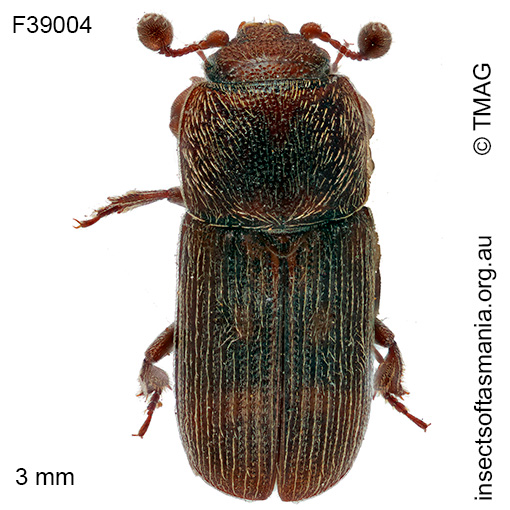
Thalycrodes cylindricum Blackburn, 1891 (a species of fruit-beetle)
Basis for Tasmanian occurrence
Semmens, T.D., McQuillan, P.B. & Hayhurst, G. (1992). Catalogue of the Insects of Tasmania. Government of Tasmania: Department of Primary Industry, 104 pp. (as Thalycrodes cylindricus)
TMAG collections
Classification
Order: Coleoptera
Suborder: Polyphaga
Superfamily: Cucujoidea
Family: Nitidulidae
Subfamily: Epuraeinae
Tribe: Epuraeini
Morphology
Typical length (mm): 3.0
Flightedness: winged and assumed capable of flight
Morphology (characterised by L. Forster): — Antennae with large, compact, globular, three-segmented club — Elytra narrow and elongate with pale-orange spots — Fore-tibiae with even spines and a bifid tooth close to apex.
Source literature on morphology and taxonomy (*primary taxonomic source, where identified):
*Blackburn, T. (1891a). Further notes on Australian Coleoptera, with descriptions of new genera and species: IX. Trans. Roy. Soc. S. Aust. 14: 65-193.
Kirejtshuk, A.G. & Lawrence, J.F. (1992). Review of the Thalycrodes complex of genera (Coleoptera: Nitidulidae) endemic to the Australian Region. Journal of the Australian Entomological Society 31: 119–142.
Ecology
Assumed larval feeding: detritivore
Association with dead wood or old trees: at least facultatively saproxylic
Ecological attributes: — Affiliated with late-aged (ex-clearfelled) forest (Michaels, 1999) — May occupy logs or trunks of Eucalyptus obliqua, at least temporarily, since found having emerged within a year of felling (Grove & Bashford, 2003) — May occupy logs or trunks of Eucalyptus obliqua, at least temporarily, since found having emerged within six years of felling (Grove et al., 2009).
Collection method(s) for TMAG material: — Emergence trapping from log of Eucalyptus obliqua — Flight intercept trapping (trough below Malaise trap) — Hand collection (substrate not specified) — Malaise trapping — Pitfall trapping.
Source ecological literature:
Grove, S.J. & Bashford, R. (2003). Beetle assemblages from the Warra log decay project: insights from the first year of sampling. Tasforests 14: 117-129.
Grove, S.J. (2009b). Beetles and fuelwood harvesting: a retrospective study from Tasmania’s southern forests. Tasforests 18: 77-99.
Baker, S.C. (2000). Forest litter beetles and their habitat: a comparison of forest regenerated by wildfire and logging practices. Hons. thesis, Univ. of Tasmania, Hobart.
Baker, S.C. (2006b). Ecology and conservation of ground-dwelling beetles in managed wet eucalypt forest: edge and riparian effects. PhD thesis, Univ. of Tasmania, Hobart.
Grove, S. et al. (2009). A long-term experimental study of saproxylic beetle … succession in Tasmanian Eucalyptus … logs… In: Fattorini, S. (Ed.), Insect Ecology and Conservation. Research Signpost, pp. 71-114.
Grove, S.J. & Yaxley, B. (2005). Wildlife habitat strips and native forest ground-active beetle assemblages in plantation nodes in northeast Tasmania. Aust. J. Entom. 44 (4): 331-343.
Michaels, K.F. (1999a). Carabid beetles as biodiversity and ecological indicators. PhD thesis, Univ. of Tasmania, Hobart.
Yee, M. (2005). The ecology and habitat requirements of saproxylic beetles native to Tasmanian wet eucalypt forests: potential impacts of commercial forestry practices. PhD thesis, Univ. of Tasmania, Hobart.

